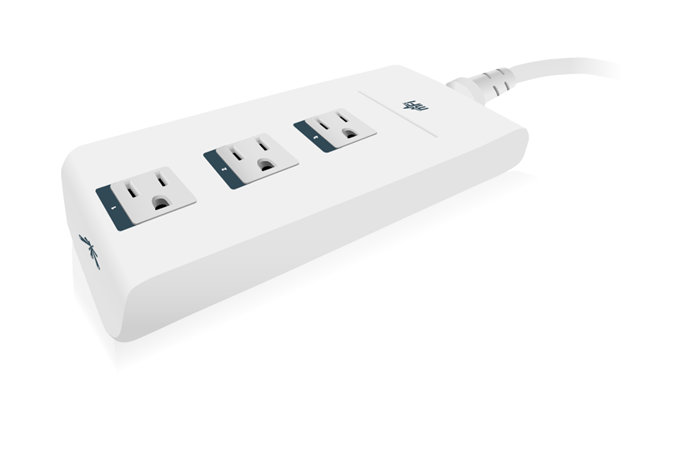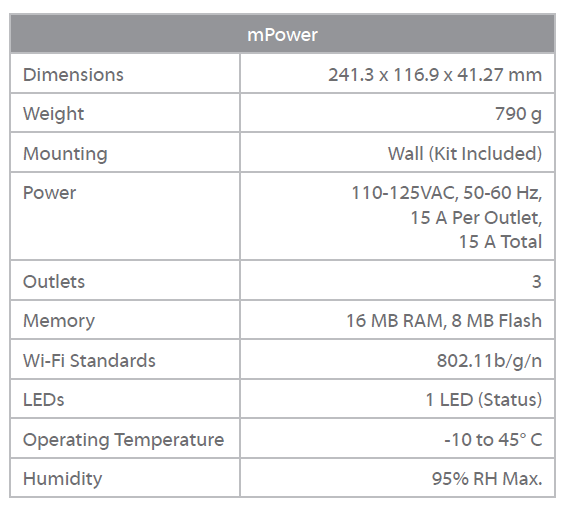Ubiquiti Networks mFi mPower Wi-Fi Power Strip Review
by Ganesh T S on November 21, 2013 3:00 AM EST- Posted in
- Home Automation
- Wi-Fi
- Ubiquiti Networks
- IoT

Introduction
The Internet of Things (IoT) revolution is happening right now. As smartphones proliferate, consumers want the ability to control devices in an automated and easy manner. Remotely switching a power outlet is one of the basic building blocks of an automation system (home or business building). Last year, we reviewed Visible Energy's UFO Power Center, a standalone device which combined energy awareness and home automation in a striking package. Today, we are looking at Ubiquiti's mPower mFi power strip. This is a device with similar features (ability to turn on/off an outlet over a wireless network and measure the power consumed by a device connected to an outlet). However, it caters to a very different market segment.
Ubiquiti Networks - Background
Ubiquiti Networks started off as a manufacturer of wireless products for enterprises, aiming mainly at emerging markets. We have generally found that their kits cost much lower than the competition (and it is attributed mainly to the fact that they don't employ a dedicated sales / marketing team). A couple of years ago, Ubiquiti started looking into expanding their product portfolio. One of the under-served product categories amongst businesses (Ubiquiti's target customers) is that of building automation. As home automation picks up steam, building automation (a term that I will use to talk about home automation technologies from the perspective of an office building) can be expected to follow. Ubiquiti launched the mFi product category to catch this wave. Ubiquiti calls the mFi as the reinvention of machine-to-machine (M2M) communication.
mFi - A Platform for Building Automation
The mFi product category consists of three main products, the mPort, mPort Serial and mPower. A number of sensors (under the mSensor category) are also included, and these interface with the mPort units through a Cat 5 cable. These include door sensors, motion detectors (both wall and ceiling varieties), temperature and current sensors. The mPort Serial provides a remote serial connection for any other devices controllable through a serial interface. Control of multiple such devices is integrated in a management software called mFi. Written in Java, it is compatible with multiple platforms.
Introducing the mPower
The product we are going to cover in detail today is the mPower. It comes in three variants, all of which support connection to a Wi-Fi network. The fundamental difference is in the number of switchable outlets. The mPower Mini has one, the mPower has three and the mPower Pro has eight. The mPower Pro also has a wired network port. Simply put, the mPower units allow the outlets to be turned on / off over the network using the mFi management software as well as a web interface. Essential statistics about each outlet (VRMS, IRMS, power factor and active power) are also reported through both avenues.
The mPower retails for around $60. The mFi controller software is bundled free with the unit. The mPower Pro (8-outlet version) retails for around $100, which represents better value per outlet. However, the Pro units were not easy to source since Ubiquiti had some supply constraints. Ubiquiti's products are not present in the usual retail channels. Instead, they are sold by B2B vendors (who sometimes have a presence on Amazon). The specifications of the mPower, as provided by Ubiquiti, are presented in the table below.

In the remainder of this piece, we will look at the setup and usage impressions, followed by details of the mPower platform. We will also present one of our custom applications developed for the mPower, thanks to its open platform. This will be followed by a few concluding remarks summarizing the pros and cons of the unit.










61 Comments
View All Comments
profquatermass - Friday, November 22, 2013 - link
I really want a Powerstrip that can operate via 3G as I often find the Router goes belly up approx. once a month. Can't turn the Router of/on again without a working line to the Internet.In true IT fashion I want to save myself a 40 mile round trip to Work late at night just to turn it off and on again....
ganeshts - Friday, November 22, 2013 - link
That is probably a very niche market :) What I can suggest for you is to get a PC with a 3G SIM slot (The Habey fanless unit we reviewed a couple of months back comes to mind -- I think that was the BIS-6922). Use that as a mFi host, and your problem is solved (and it opens up lots of other possibilities too). That way, your 3G subscription is not just tied to a power-strip, but, can be used to automate your whole office / be used for other purposes too, as the BS-6922 is a complete fanless industrial PC.TheCrackLing - Tuesday, December 3, 2013 - link
From the way this device sounds, you could make a script that runs via a cronjob that would ping several well known sites that generally respond to pings, and if all fail to respond then power cycle the port the router is on. Of course also make certain to log the time, and not power cycle again for X time after.dblagent - Tuesday, December 3, 2013 - link
they absolutely make this, you want what is called and "IP Powerstone" by multi-link inc. They are not much, and they work GREAT! There are a few models, ours is around $100 I believe.You give it power via a standard computer style power cord and it has two outlets. It is connected via cat5 to your router and you set what sites (up to 5) to ping and how often. If it misses a ping it will wait and try again in a few minutes. If not available then it powercycles the outlets. One at a time, or both. Timing is set by you. I wait 5, then 15, then one hour. After three times you'll possibly have to make the trip.
I use 80 of these at remote locations and they work great! Used to I'd dispatch someone to head to the location where now we just wait. Maybe once every month or two someone has to go onsite now. It used to be weekly with 80+ locations that are remotely controlled!
Hope this helps you, it is an amazing help for us that's for sure!
Dantze - Saturday, November 23, 2013 - link
Been following Anandtech for yeaaarss.. but finally had to say it. Is there an option to view the articles in one page format rather than having to click on drop down for each different section ?I think it's... cumbersome.. should have an option like HowStuffWorks where you can see the article as a one page (long) article.
ganeshts - Saturday, November 23, 2013 - link
Click on 'Print this article' at the bottom of the screen :) I thought this was a well-known feature.Dantze - Sunday, November 24, 2013 - link
Thanks that works! :DDBissett - Monday, November 25, 2013 - link
That's a small improvement. It would be a great improvement if the Print view would give you the article full screen width and get rid of all the junk on the right. If you want to let readers concentrate on reading an article why include headlines, tweets, etc. on the screen?Catsweeper - Monday, November 25, 2013 - link
Looks like a great productraptorl3 - Tuesday, December 3, 2013 - link
Is there any chance of sending an on/off command to the strip without using the dedicated app? I'm thinking, for instance, of turning on a dedicated stereo amplifier over WiFi. I control the XBMC source with a tablet or phone. By creating a Tasker or Llama action (in Android, obviously) I could both switch on the amp and launch the XBMC remote on the device. A similar task could switch the amp off after a period of non-use.This would be much more difficult if all actions must be handled through the app or SSH only.